
The Barcelona Metro is a network of rapid transit electrified railway lines that run mostly underground in central Barcelona and into the city's suburbs. It is part of the larger public transport system of Barcelona, the capital of Catalonia, Spain, with unified fares under the Autoritat del Transport Metropolità (ATM) scheme. As of 2014, the network is operated by two separate companies: Transports Metropolitans de Barcelona (TMB) and Ferrocarrils de la Generalitat de Catalunya (FGC). It is made up of 12 lines, combining the lines owned by the two companies. Two lines, L9 and L10, are being built at present, with both lines having different sections of each opened between 2009 and 2018. They are due to be fully completed in 2026. Three lines on the network have opened as automatic train operation/driverless vehicle systems since 2009: Line 11 being converted to driverless first, and then Lines 9 and 10, opening up driverless.

The Seville Metro is an 18-kilometre (11 mi) light metro network serving the city of Seville, Spain and its metropolitan area. The system is totally independent of any other rail or street traffic. All 22 stations were built with platform screen doors.

The Caracas Metro is a mass rapid transit system serving Caracas, Venezuela. It was constructed and is operated by Compañía Anónima Metro de Caracas, a government-owned company that was founded in 1977 by José González-Lander who headed the project for more than thirty years since the early planning stages in the 1960s. Its motto is "Somos parte de tu vida". In 1978 MTA – New York City Transit's R46 #816 was shipped from the Pullman Standard's plant as a sample of rolling stock to be used for the new metro system that was under construction at the time.

The Xochimilco Light Rail is a light rail line that serves the southern part of Mexico City. It connects to, but is not considered a part of, the Mexico City Metro. Rather, it is operated by the Servicio de Transportes Eléctricos (STE), the authority that operates Mexico City's electric trolleybus system and formerly operated the municipal electric tram system.
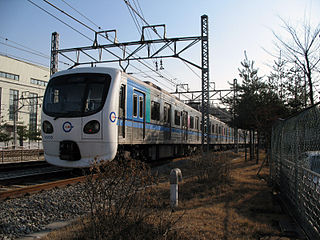
The Incheon Subway is a subway system serving the South Korean city of Incheon. The system is operated by Incheon Transit Corporation, and is part of the greater Seoul Metropolitan Subway.
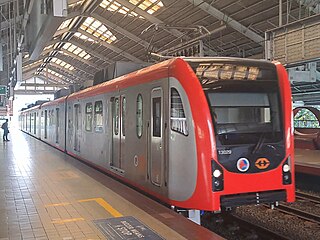
The Manila Light Rail Transit System, commonly known as the LRT, is an urban rail transit system that primarily serves Metro Manila, Philippines. Although categorized as a light rail system because it originally used light rail vehicles, it presently has characteristics of a rapid transit system, such as high passenger throughput, exclusive right-of-way, and later use of full metro rolling stock. The LRT is jointly-operated by the Light Rail Transit Authority (LRTA), a government corporation attached to the Department of Transportation (DOTr), and the Light Rail Manila Corporation (LRMC). Along with the Manila Metro Rail Transit System and the Metro Commuter Line of the Philippine National Railways, the system makes up Metro Manila's rail infrastructure.

Metrorrey, officially Sistema de Transporte Colectivo Metrorrey, is a rapid transit system that serves the metropolitan area of Monterrey. It is operated by the Sistema de Transporte Colectivo Metrorrey, which is part of the decentralized public administration of Nuevo León. In 2022, it was the sixth largest metro system in North America by ridership.
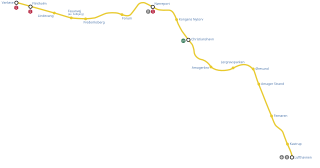
M2 is a line of the Copenhagen Metro, colored yellow on the map. It runs from Vanløse to Lufthavnen through the center of Copenhagen, sharing track with the M1 from Vanløse to Christianshavn. The line was built along with M1 as part of the redevelopment of Ørestad. The principle of the line was passed in 1992, and construction commenced in 1998. The line opened in several stages between 2002 and 2007. It is owned by Metroselskabet and operated by Metro Service, and operates with a headway between four and twenty minutes.
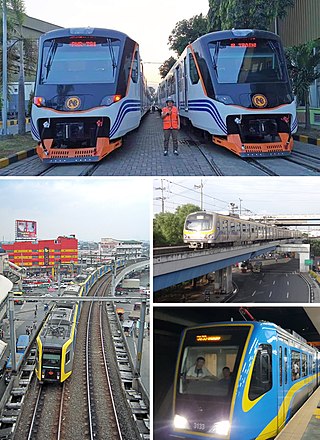
Rail transportation in the Philippines is currently used mostly to transport passengers within Metro Manila and provinces of Laguna and Quezon, as well as a commuter service in the Bicol Region. Freight transport services once operated in the country, but these services were halted. However, there are plans to restore old freight services and build new lines. From a peak of 1,100 kilometers (680 mi), the country currently has a railway footprint of 533.14 kilometers (331.28 mi), of which only 129.85 kilometers (80.69 mi) are operational as of 2024, including all the urban rail lines. World War II, natural calamities, underspending, and neglect have all contributed to the decline of the Philippine railway network. In the 2019 Global Competitiveness Report, the Philippines has the lowest efficiency score among other Asian countries in terms of efficiency of train services, receiving a score of 2.4, and ranking 86th out of 101 countries globally. The government is currently expanding the railway network up to 1,900 kilometers (1,200 mi) by 2022 through numerous projects.

The Sistema de Tren Eléctrico Urbano or SITEUR is an urban rail transit system serving the Guadalajara metropolitan area, in the municipalities of Guadalajara, Zapopan and Tlaquepaque, in the state of Jalisco, Mexico. It is owned and operated by the state of Jalisco.

The Los Teques Metro is a suburban mass-transit system in the city of Los Teques, Venezuela with connections to important surrounding cities and communities. It was opened to public service on November 3, 2006. The Los Teques Metro currently operates one service connecting 5 stations, with additional stations for Line 2 under construction.

Metrovalencia is an urban rail including rapid transit and trams, serving Valencia and its metropolitan area. The network is a modern amalgamation of former FEVE narrow gauge electric-operated suburban railways. It is a large suburban network that crosses the city of Valencia, with all trains continuing out to the suburbs. It also has destinations on lines that make it more closely resemble commuter trains. The unique system combines light railway, metro and several tram operations north of the Túria riverbed park with line 4. Trains of lines 1, 3, 5 and 9 have automatic train operation (ATO) in 25.3 kilometers of underground system. Tram lines 4, 6, 8 and 10 are operated by modern trams.
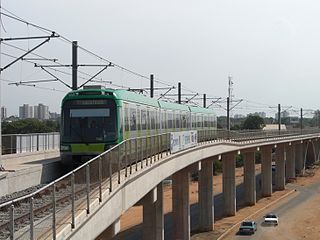
The Maracaibo Metro, also known as Metro del Sol Amado, is a six-station light rail system in Maracaibo, Venezuela. Service between La Vanega and El Varillal opened to the public on 25 November 2006, with the last station on the line opened on 9 June 2009.

Light rail is a commonly used mode of public transit in North America. The term light rail was coined in 1972 by the Urban Mass Transportation Administration to describe new streetcar transformations which were taking place in Europe and the United States. The Germans used the term Stadtbahn, which is the predecessor to North American light rail, to describe the concept, and many in UMTA wanted to adopt the direct translation, which is city rail. However, in its reports, UMTA finally adopted the term light rail instead.

The Metropolitan of Fortaleza, also known popularly as Metro of Fortaleza or Metrofor, is a system of metropolitan transport that operates in the Brazilian city of Fortaleza, operated by Companhia Cearense de Transportes Metropolitanos, company of social capital, captained by the Government of the State of Ceará, in Brazil, and has as current president Eduardo Hotz. Founded on May 2, 1997, the company is responsible for administration, construction and metro planning in the state of Ceará, being present in the systems of Sobral and Cariri, having its main activity in Fortaleza and its metropolitan region.

Servicio de Transportes Eléctricos de la Ciudad de México (STE) is a public transport agency responsible for the operation of all trolleybus and light rail services in Mexico City. As its name implies, its routes use only electrically powered vehicles. It was created on 31 December 1946 and is owned by the Mexico City government. STE is overseen by a broader local governmental authority, Secretaria de Movilidad de la Ciudad de México (SEMOVI)(Secretariat of Mobility of Mexico City), formerly (SETRAVI) which also regulates the city's other public transport authorities, including Sistema de Transporte Colectivo, Red de Transporte de Pasajeros del Distrito Federal and Metrobús, as well as other forms of transportation in the district. STE's passenger vehicle fleet consists exclusively of trolleybuses, light rail, and aerial lift vehicles, and in 2007 its network carried 88 million passengers, of which 67 million were on trolleybus services and 21 million on light rail.

Adana Metro is a rail rapid transit system extending 13.5 kilometers (8.39 mi) along a north–south corridor through Adana, with 13 stations. It can transport 21,600 passengers per hour per direction. The total travel time on the metro, end to end, takes 21 minutes, including all stops.
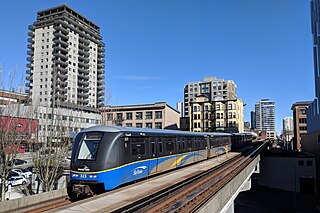
Urban rail transit in Canada encompasses a broad range of rail mass transit systems, including commuter rail, rapid transit, light rail, and streetcar systems.

Rail transportation in the Greater Manila Area is a major part of the transportation system in Metro Manila and its surrounding areas. It consists of the Manila Light Rail Transit System, Manila Metro Rail Transit System, and the PNR Metro Commuter Line. The network makes up the majority of active railways in the country and bear the brunt of providing the metropolis with rail as a faster alternative mode of transport other than buses and jeepneys. However, these systems are currently insufficient for the rapidly expanding metropolis; to address this, new lines and line extensions are under construction, which will extend the system far out into neighboring regions.


















